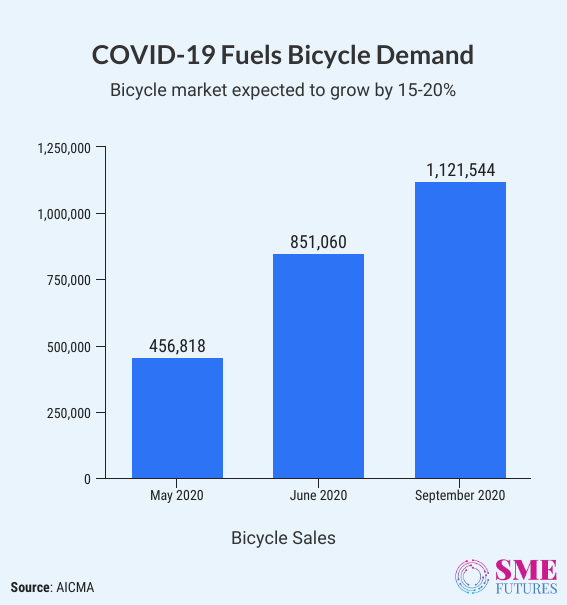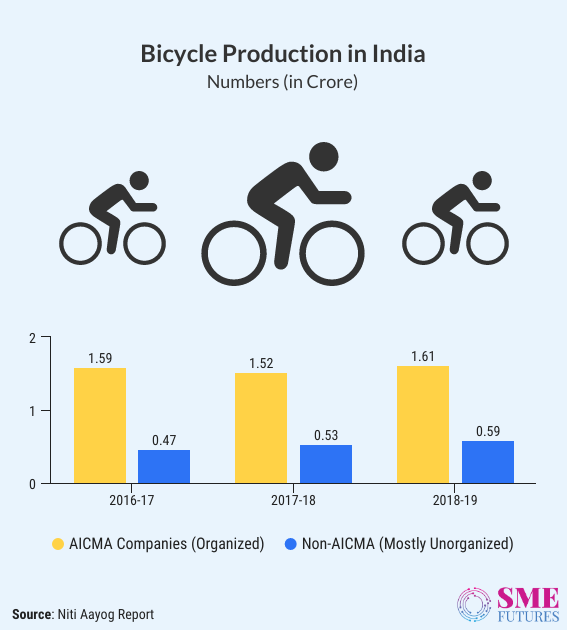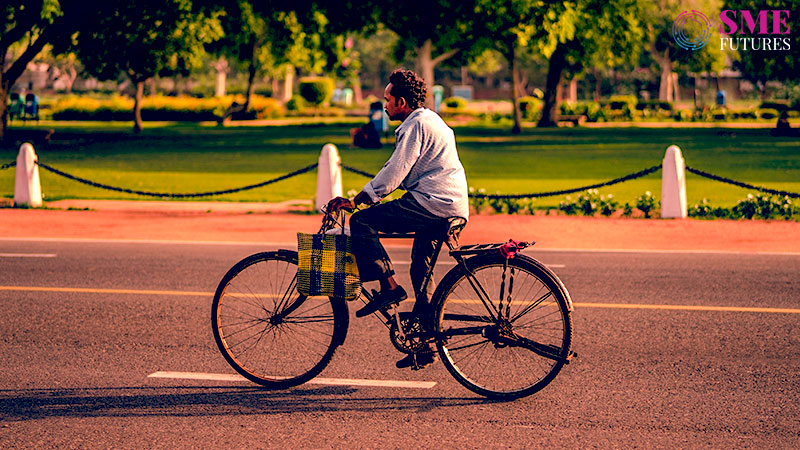Pandemic has brought many new trends as a mode of adaptation to the new normal. The latest trend in which people are indulging is cycling. All across the world, people have rediscovered the love for cycling in the pandemic era. From solo cyclist to biking groups, people riding bicycles are now a common sight on roads.
This has led to a significant surge in demand of bicycles. It all started when social distancing became the new order and government constricted mobility of individuals. As a result, people were confined to their homes. Furthermore, the need for staying active as gyms and sports centers were closed, fuelled the boom in bicycle industry.
Cycling – A latest craze in India
Cycling has been a latest craze in India. People opted for cycling as a physical activity during lockdown which increased the demand of bicycles in market. India is the second largest producer of bicycles in the world after China. It is enjoying this latest boost as sales soared two-fold in last six months. Hero cycles, largest cycle maker clocked 250 per cent sales jump in premium cycles.
According to data provided by the industry association, 22 million units were manufactured and sold in 2018-19. The annual turnover for that year was Rs 7,000 crore. However, the total units sold for 2019-20 were 18 million. All India Cycle Manufacturers Association (AICMA), an apex body in the sector states about sales figure in past few months. It tells in statement that a total of 41,80,945 units of bicycles have been sold in the country from May to September 2020.
“No one expected that sales will boost in such manner. My sales have been boosted by five to six times,” says Vivek Wadhwa, owner of Supreme Cycle Company in Delhi which supplies bicycles at wholesale prices. He further tells us that their business has skyrocketed and bicycle of range between Rs 10,000 and Rs 25,000 are mostly in demand.
Similarly, Chandrakant Jain, proprietor at Jain Cycle Store in Katni, Madhya Pradesh is witnessing a surge in demand these days. While speaking to us he elaborates, “I can see that a craze of bicycles among people especially in younger generation has increased. This interest was generated during shutdown of gyms and sports centers.” Another stakeholder in the industry and President of Rajdhani Cycle Dealers Association Rajiv Batra says, “Cycle business did not suffer such a loss although people in other trades suffered a lot.”
Excited with the unprecedented growth, Secretary General of AICMA, KB Thakur feels that the increase in demand for bicycles is unprecedented. He said in a statement, “Probably for the first time in history, such a trend has been seen in the sector.”
According to AICMA, sales of bicycles have gone up by over 100 per cent in the last few months. In many places, people have pre-ordered and are still waiting for their products.
In May, the number of bicycles sold were 4,56,818. This number almost doubled to 8,51,060 in June. However, the country sold 11,21,544 cycles in September. This is what bicycle industry has been witnessing in past few months with the lockdown. Earlier, the industry was growing at 5 to 7 per cent each year but due to the pandemic, the sector is expected to grow at 15 to 20 per cent. A majority portion of the demand was led by its first-time users.

High demand industry with meagre supply
The sales of bicycles may have gone up, but the wait to buy a bicycle is still long. Due to the unprecedented surge in bicycle demand, retailers and wholesalers are not able to match the pace of supply. “The demand is good but we do not have supplies to meet the demand. It is because of delay of the stock of bicycle that comes from Ludhiana,” informs Sunil Kumar of Chandni Chowk’s bicycle market.
Lately, supply is constrained in the market. This can be gauged by the fact that wholesaler and retailers are not able to convert enormous demand into sales. The main reason behind it is shortage of raw materials. Wadhwa of Supreme Cycles tells, “The current scenario is that we are not getting products from manufacturers on time. The reason is that OEMs or component manufacturers are not able to manufacture parts and this in turn is hampering manufacturing.”
Echoing with Wadhwa, bicycle retailer Jain says that though they are demanding more bicycles from the suppliers, there still is shortage of products. This is because of less supply of raw materials. “Whatever sales are happening is supply-led sales and after it there is unfulfilled demand. These numbers can’t be predicted easily. But, kids and premium cycles are doing well,” he informs.
Pandemic imposed hurdles in manufacturing
Stakeholders of sector feel that demand have boosted at most inopportune time. Ludhiana being the manufacturing hub is experiencing a jolt of Kisaan Andolan since October due to obstruction of roads and railway tracks. As per ASSOCHAM estimates, India inc is facing a daily loss of Rs 3,000-3,500 crore from the value chain and transport disruption because of protests. Umesh Narang, Convener of G-13 Bicycle Forum, an association of small and medium manufacturers is of opinion that Ludhiana is known for bicycle, sewing machines, and industry goods.
There is an extreme shortage of raw material currently. He explains, “Raw materials for cycle industry reach Ludhiana mostly through trains from Raipur and Bokaro. Due to the protest of farmers, we are facing a major crisis and material crunch. As a result, work is on halt in local units. This in turn has also caused increase in raw material import prices as well.”
Apart from the raw material from steel plants, manufacturers are also facing shortage of necessary components such as gear systems which are imported mainly from China. Elaborating on this, Narang says, “At least 95 per cent of components are manufactured in India, but for hi-end and hybrid bicycles there are some components which we import mainly from China. The trade tensions have sabotaged the manufacturing of these parts. Adding to it, rail roko movement has further aggravated the raw material crunch.”
Bicycle assembly essentially needs more than 100 components, and the cycle industry in Ludhiana depends on China for the import of multi-speed gears, alloy frames, steel rims, reflectors, brakes among others. Companies such as Shimano and SRAM are the main exporters. Apex bodies in the industry are already looking for new markets and have started importing from countries such as Taiwan.

Current trends and challenges of cycling industry
Despite cycling is increasing as an activity in urban cities, the trend is shrinking in rural areas. According to an industry source, demand for rural areas is uncharacteristically low in the post-COVID months. However, other mobility vehicle sales are on rise. Seeing these trends, industry players have urged the central government to curb this demand challenge.
Hero Cycles in a statement urged government to provide policy support, including easy loans and subsidies, to support demand in the rural areas. Boosting bicycle usage through policy initiatives will not only increase the demand for it but will also fuel economic activities and new avenues for income generation in rural areas, the statement claims.
According to Pankaj Munjal, Chairman and MD of Hero Cycles Limited, the increased demand is mostly on account of fitness and recreation bike categories. The demand for bicycles priced at Rs 10,000 and above has been unprecedented but the mass segment which is also the most affordable one has witnessed stagnancy resulting in low demand.
“We want the government to initiate some supportive policy measures that helps in rebound of the sliding rural demand”
Pankaj Munjal, Chairman and MD of Hero Cycles Limited
Cycling culture emerging after lockdown has created a positive buzz among cycle manufacturers. However, the rural demand has failed to catch up with the trend. Low bicycle demand in rural India is a major indication of economic distress among the rural workers. Munjal also admits that with a massive reverse migration post lockdown, the rural economy is overburdened with the workforce.
Job and income losses in urban areas have forced many migrants to return to their villages and small towns. He says, “Improving bicycle ownership can help in creating greater avenues for income generation and spur much-needed economic activity. The government must consider slashing GST, particularly on low-end bicycles apart from creating avenues for easy bicycle loans and launch schemes for subsidizing bicycle sales to the rural poor.”
Narang echoes with the thought. He suggests that though we are seeing a manufacturing debacle but taxes can be lowered to raise demand such as GST which will make them more affordable. “Bicycles are currently taxed at 12 per cent GST, and reducing the same to 5 per cent can make them more affordable to a larger consumer base,” he opines.
Other challenges that cycle is keeping cycle aficionados off from cycling is the cost of good bicycles and the infrastructure. Abhishek, a cycling enthusiast from Kolkata says, “Cycling is a phenomenon which has not yet gained the momentum it deserves. Indian government has been trying quite hard to encourage cycling (petrol prices are hiked, BS6 is introduced) but the infrastructure is not yet developed for it.”
Expressing his views, he says, “In fact in Kolkata, cycling is prohibited on many roads. I feel that cycling is the best mode of transport as it prevents serious accidents, burns a lot of fat, strengthens the body, and improves blood circulation. I wish vehicles which burn petrol or diesel were not invented,” Although, India has introduced steps such as a Cycles4Change Challenge which aims to inspire cities to implement quick cycling-friendly interventions.
Another constraint includes cost of good bicycles. The cost ranges between Rs 40,000 and Rs 60,000 rupees. It is an amount that most Indian households will think twice before spending. Other challenge is dependency for parts. It may be noted that a lot of bicycle components comes from China and cyclist have urged Indian manufacturers to make these components in the country at cheaper costs. Earlier, Hero Cycles had cancelled Rs 900 crore worth deals with China earlier in July to boycott Chinese products.
Meanwhile, MSME bicycle manufacturers have also urged government to take some measures to be self-reliant. Umesh Narang explains, “Cycle manufacturing depends upon components such as aluminum gears which are not manufactured in India at all and are imported from China. Disruption of supply chain which we are facing today would not been the case, if we were manufacturing these components here only.”
He further informs that a collective of manufacturers have written a descriptive letter to government to roll out an incentive package of Rs 5000 crore for bicycle industry. “Industry wants to set up a factory to manufacture complex components, currently being imported. The package will act as an incentive to support to set up this machinery in Ludhiana and encourage us to manufacture aluminum gear.”
If this happens, India can stop importing components from China within one-year and become sole independent manufacturer taking care of entire demand of bicycles across the country. “We want government to finance us, give us some moratorium period. This measure in turn will generate employment and will also bring down the price,” claims Narang.
If costs for good bicycles reduce in future; cycling could become much more than just a sport or an activity in the country. Going ahead, this new-found love for bicycles can be a capitalizing point for an already struggling industry. Stakeholders hope that air of awareness that pandemic and lockdowns have created paves the way of steady growth for the market.











